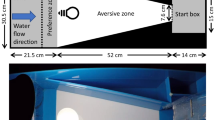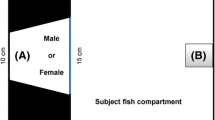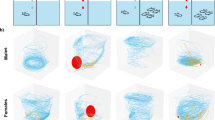Abstract
In predator–prey interactions, the prey often have to compromise fitness-related behaviors such as feeding, courting, and territorial defense in order to avoid predators. In these trade-off situations, some behaviors have priority over others. These priorities are not rigid, and may be context-dependent; for instance, many animals show increased risk-taking during courtship behavior by paying less attention to potential predators. We investigated whether the fright reaction, a stereotypical avoidance response to olfactory cues from injured conspecifics, may be affected by reproductive status in a teleost fish, the crucian carp. We demonstrate that among individuals not responding to alarm substances with a fright reaction, the majority were ovulated or spermiated. In females, mean plasma concentrations of 17β-estradiol and testosterone, gonadal steroids known to decrease during the later stages of sexual maturation, were lower in the individuals not responding with a fright reaction compared to those responding. In males, there were no differences between responsive and non-responsive individuals in mean plasma levels of androgens (testosterone and 11-ketotestosterone) involved in spermatogenesis and male sexual behavior. As the fright reaction in crucian carp consists of behavior incompatible with spawning behavior, we hypothesize that this short-term suppression of the alarm response has evolved so that spawning can occur uninterrupted.


Similar content being viewed by others
References
Bjerselius, R., Olsen, K. H., and Zheng, W. H. 1995. Endocrine, gonadal and behavioral-responses of male crucian carp to the hormonal pheromone 17α,20β-dihydroxy-4-pregnen-3-one. Chem. Senses 20:221–230.
Borg, B. 1994. Androgens in teleost fishes. Comp. Biochem. Physiol. C Pharmacol. Toxicol. Endocrinol. 109:219–245.
Brown, G. E., and Smith, R. J. F. 1997. Conspecific skin extracts elicit antipredator responses in juvenile rainbow trout (Oncorhynchus mykiss). Can. J. Zool. 75:1916–1922.
Brown, G. E., Rive, A. C., Ferrari, M. C. O., and Chivers, D. P. 2006. The dynamic nature of antipredator behavior: prey fish integrate threat-sensitive antipredator responses within background levels of predation risk. Behav. Ecol. Sociobiol. 61:9–16.
Candolin, U. 1997. Predation risk affects courtship and attractiveness of competing threespine stickleback males. Behav. Ecol. Sociobiol. 41:81–87.
Chivers, D. P., and Smith, R. J. F. 1998. Chemical alarm signalling in aquatic predator-prey systems: a review and prospectus. Ecoscience 5:338–352.
Dill, L. M., Hedrick, A. V., and Fraser, A. 1999. Male mating strategies under predation risk: do females call the shots? Behav. Ecol. 10:452–461.
Dulka, J. G., Stacey, N. E., Sorensen, P. W., and Vanderkraak, G. J. 1987. A steroid sex-peromone synchronizes male-female spawning readiness in goldfish. Nature 325:251–253.
Endler, J. A. 1987. Predation, light intensity and courtship behavior in Poecilia reticulata (Pisces- Poeciliidae). Anim. Behav. 35:1376–1385.
Farr, J. A. 1975. Role of predation in evolution of social-behavior of natural-populations of guppy, Poecilia reticulata (Pisces-Poeciliidae). Evolution 29:151–158.
Godin, J. G. J., and Dugatkin, L. A. 1996. Female mating preference for bold males in the guppy, Poecilia reticulata. Proc. Natl. Acad. Sci. U S A 93:10262–10267.
Hamdani, E. H., and Døving, K. B. 2006. Specific projection of the sensory crypt cells in the olfactory system in crucian carp, Carassius carassius. Chem. Senses 31:63–67.
Hamdani, E. H., Stabell, O. B., Alexander, G., and Døving, K. B. 2000. Alarm reaction in the crucian carp is mediated by the medial bundle of the medial olfactory tract. Chem. Senses 25:103–109.
Hamdani, E. H., Lastein, S., Gregersen, F., and Døving, K. B. 2008. Seasonal variations in olfactory sensory neurons—fish sensitvity to sex pheromones explained? Chem. Senses 33:119–123.
Höglund, E., Weltzien, F. A., Schjolden, J., Winberg, S., Ursin, H., and Døving, K. B. 2005. Avoidance behavior and brain monoamines in fish. Brain Res. 1032:104–110.
Kavaliers, M., and Choleris, E. 2001. Antipredator responses and defensive behavior: ecological and ethological approaches for the neurosciences. Neurosc. Biobehav. Rev. 25:577–586.
Kavaliers, M., Choleris, E., and Colwell, D. D. 2001. Brief exposure to female odors “emboldens” male mice by reducing predator-induced behavioral and hormonal responses. Horm. Behav. 40:497–509.
Kobayashi, M., Sorensen, P. W., and Stacey, N. E. 2002. Hormonal and pheromonal control of spawning behavior in the goldfish. Fish Physiol. Biochem. 26:71–84.
Koss, W. A., Gehlert, D. R., and Shekhar, A. 2004. Different effects of subchronic doses of 17-beta estradiol in two ethologically based models of anxiety utilizing female rats. Horm. Behav. 46:158–164.
Lastein, S., Hamdani, E. H., and Døving, K. B. 2006. Gender distinction in neural discrimination of sex pheromones in the olfactory bulb of crucian carp, Carassius carassius. Chem. Senses 31:69–77.
Lima, S. L., and Dill, L. M. 1990. Behavioral decisions made under the risk of predation—a review and prospectus. Can. J. Zool. 68:619–640.
Lunga, P., and Herbert, J. 2004. 17 beta-oestradiol modulates glucocorticoid, neural and behavioural adaptations to repeated restraint stress in female rats. J. Neuroendocrinol. 16:776–785.
Magnhagen, C. 1991. Predation risk as a cost of reproduction. Trends Ecol. Evolution 6:183–185.
Mathis, A., and Smith, R. J. F. 1993. Intraspecific and cross-superorder responses to chemical alarm signals by brook stickleback. Ecology 74:2395–2404.
Pall, M. K., Mayer, I., and Borg, B. 2002. Androgen and behavior in the male three-spined stickleback, Gasterosteus aculeatus I.—Changes in 11-ketotestosterone levels during the nesting cycle. Horm. Behav. 41:377–383.
Pfeiffer, W. 1963. Alarm substances. Experientia 19:1–11.
Poling, K. R., Fraser, E. J., and Sorensen, P. W. 2001. The three steroidal components of the goldfish preovulatory pheromone signal evoke different behaviors in males. Comp. Biochem. Physiol. B Biochem. Mol. Biol. 129:645–651.
Schutz, F. 1956. Vergleichende Untersuchungen über die Schreckreaktion bei Fischen und deren Verbreitung. Z. vegleich. Physiol. 38:84–135.
Smith, R. J. F. 1973. Testosterone eliminates alarm substance in male fathead minnows. Can. J. Zool. 51:875–876.
Smith, R. J. F. 1976. Seasonal loss of alarm substance cells in North-American cyprinoid fishes and its relation to abrasive spawning behavior. Can. J. Zool. 54:1172–1182.
Stacey, N. E., and Liley, N. R. 1974. Regulation of spawning behavior in female goldfish. Nature 247:71–72.
Stacey, N., Fraser, E. J., Sorensen, P., and Van der kraak, G. 2001. Milt production in goldfish: regulation by multiple social stimuli. Comp. Biochem. Physiol. C Toxicol. Pharmacol. 130:467–476.
Strong, D. R. 1973. Amphipod-amplexus, significance of ecotypic variation. Ecology 54:1383–1388.
Von Frisch, K. 1938. Zur Psychologie des Fisch-schwarmes. Naturwissenschaften 26:601–606.
Weltzien, F. A., Höglund, E., Hamdani, E. H., and Døving, K. B. 2003. Does the lateral bundle of the medial olfactory tract mediate reproductive behavior in male crucian carp? Chem. Senses 28:293–300.
Wisenden, B. D. 2000. Olfactory assessment of predation risk in the aquatic environment. Philos. Trans. R. Soc. Lond. B Biol. Sci. 355:1205–1208.
Acknowledgments
This study was supported by the Norwegian Research Council (grants 159213/V40 and 172609/S40).
Author information
Authors and Affiliations
Corresponding author
Rights and permissions
About this article
Cite this article
Lastein, S., Höglund, E., Mayer, I. et al. Female Crucian Carp, Carassius carassius, Lose Predator Avoidance Behavior when Getting Ready to Mate. J Chem Ecol 34, 1487–1491 (2008). https://doi.org/10.1007/s10886-008-9553-9
Received:
Revised:
Accepted:
Published:
Issue Date:
DOI: https://doi.org/10.1007/s10886-008-9553-9




